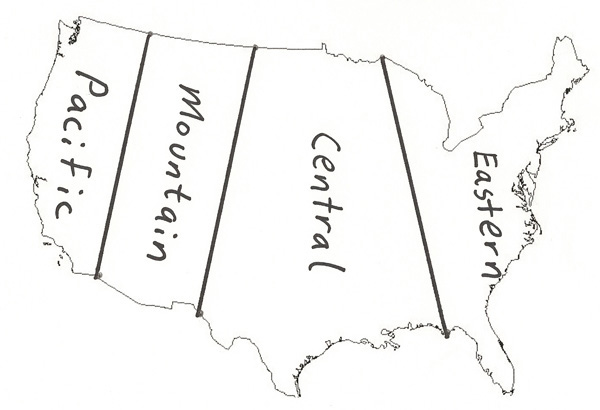
| TIME ZONES AND SAVINGS TIME
| |||||||||||||||||||||||||||||||||||||||||||||||||||||||||||||||||||||||||||||||||||||||||||||||||||||||||||||||||||||||||||||||||||||||||||||||||||||||||||||||||||||||||||||||||||||||||||||||||||||||||||||||||||||||||||||||||||||||||||||||||||||||||||||||||||||||||||||||||||||||||||||||||||||||||||||||||||||||||||||||||||||||||||||||||||||||||||||||||||||||||||||||||||||||||||||||||||||||||||||||||||||||||||||||||||||||||||||||||||||||||||||||||||||||||||||||||||||||||||||||||||||||||||||||||||||||||||||||||||||||||||||||||||||||||||||||||||||||||||||||||||||||||||||||||||||||||||||||||||||||||||||||||||||||||||||||||||||||||||||||||||||||||
METEOROLOGIST JEFF HABY
The continental United States has 4 primary time zones. The approximated position of these time zones is shown on the diagram below. The 4 main
time zones are Eastern, Central, Mountain and Pacific. Across the globe, the time zones tend to converge toward the pole. This is because
the Earth spins fastest at the equator and slower at the poles. Another way of looking at this is that the geographic size of the land
area is greater between the lines of longitude when comparing equatorial to polar areas. This tendency can best be seen in the U.S. when
looking at the time zone borders of the Central time zone. The Central time zone is wider in the southern United States and thinner
in the northern United States. The time zones are needed so that the time of the day in each time zone occurs when the sun is in a similar
position in the sky. Since most humans sleep during some portion of night and are awake at some portion during the day, time zones help
people in difference parts of the country experience similar day and night conditions at the same relative time on the clock. For example,
the sun sets at a similar time in the late afternoon/evening for all people. When people communicate from different time zones, the times
on the clock will be different by one hour for each time zone they are away from each other. For example, a person in the Pacific time
zone will be 3 hours earlier than a person in the Eastern time zone. The Earth spins counterclockwise when viewed above the North Pole.
As a result, the sun rises in the east and sets in the west. Thus, in the United States the time zones will progressively go to earlier
hourly times when moving toward the west since the sun sets last in the west.
Twice a year for many locations in the United States, the clocks need to be changed by one hour. “Fall back” results in moving the clock back
an hour in the Fall and “spring forward” results in moving the clock forward an hour in the Spring. The time of the year with shortest
sunlight in the continental United States is in the late Fall and early Winter. Thus, the clock is moved back by one hour in the Fall
to allow for an hour of extra sunlight in the morning. This results though in the sun setting an hour earlier. The rationale behind this
is to give extra light in the morning for school kids and for people to get to work. The downside is that it is very inconvenient to
change the times on the clocks twice a year. Many people have a large number of clocks (in car, wrist watch, in home, on appliances,
electronics. etc.). Typically the phones and computers adjust automatically. It may be easier in this age in our history to adjust
schedules rather than changing the clock time twice every year. Thus, it could be possible that at some point in the future that
the clocks will stay on the same time they are in the summer without having to adjust the time by one hour in the Fall and again
in the Spring.

|
|
|

